Last Updated on December 17, 2017
I have to admit that I had never even heard of Guayaquil before I flew to Ecuador. And I don’t know if I would’ve gone there had I not started my trip to the Galápagos Islands in Guayaquil, from where several flights a day leave for Baltra Island in the Galápagos.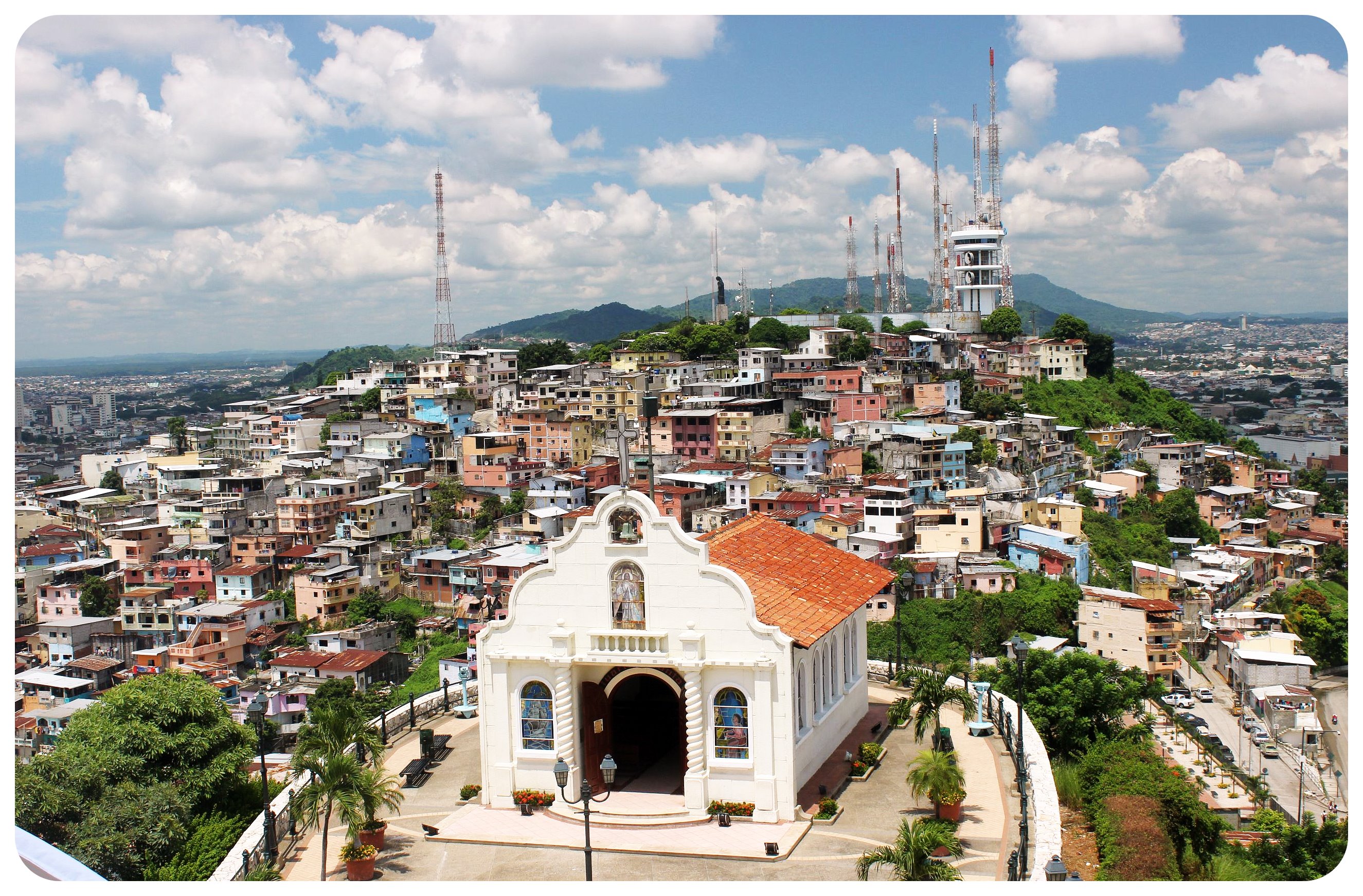 When I did do some research about the city, I found a few sights that sounded like they were worth visiting mentioned in travel guides, and I decided that Guayaquil sounded interesting enough to spend a few days after my cruise.
When I did do some research about the city, I found a few sights that sounded like they were worth visiting mentioned in travel guides, and I decided that Guayaquil sounded interesting enough to spend a few days after my cruise.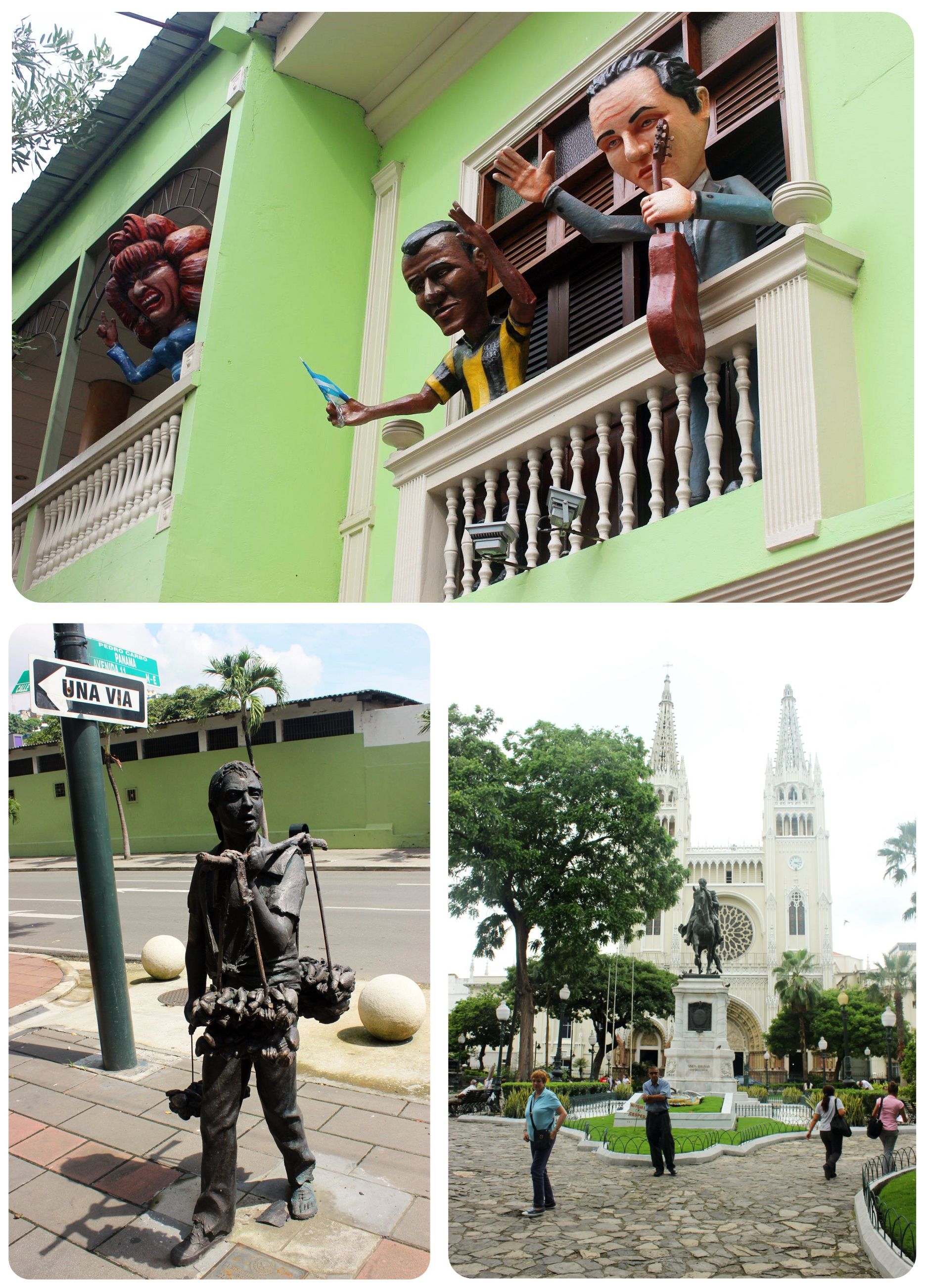 However, the city didn’t make it easy for me to love it. It didn’t wow me with its architecture, and it wasn’t particularly charming. It was rainy and cloudy during my stay, and even though I spent five days in town, I never found a place to eat that I truly loved.
However, the city didn’t make it easy for me to love it. It didn’t wow me with its architecture, and it wasn’t particularly charming. It was rainy and cloudy during my stay, and even though I spent five days in town, I never found a place to eat that I truly loved. The main attraction of the city seemed to be the revamped Malecon 2000, and I had chosen well with the place I was staying at: a stylish, new hostel right across from the Malecon.
The main attraction of the city seemed to be the revamped Malecon 2000, and I had chosen well with the place I was staying at: a stylish, new hostel right across from the Malecon.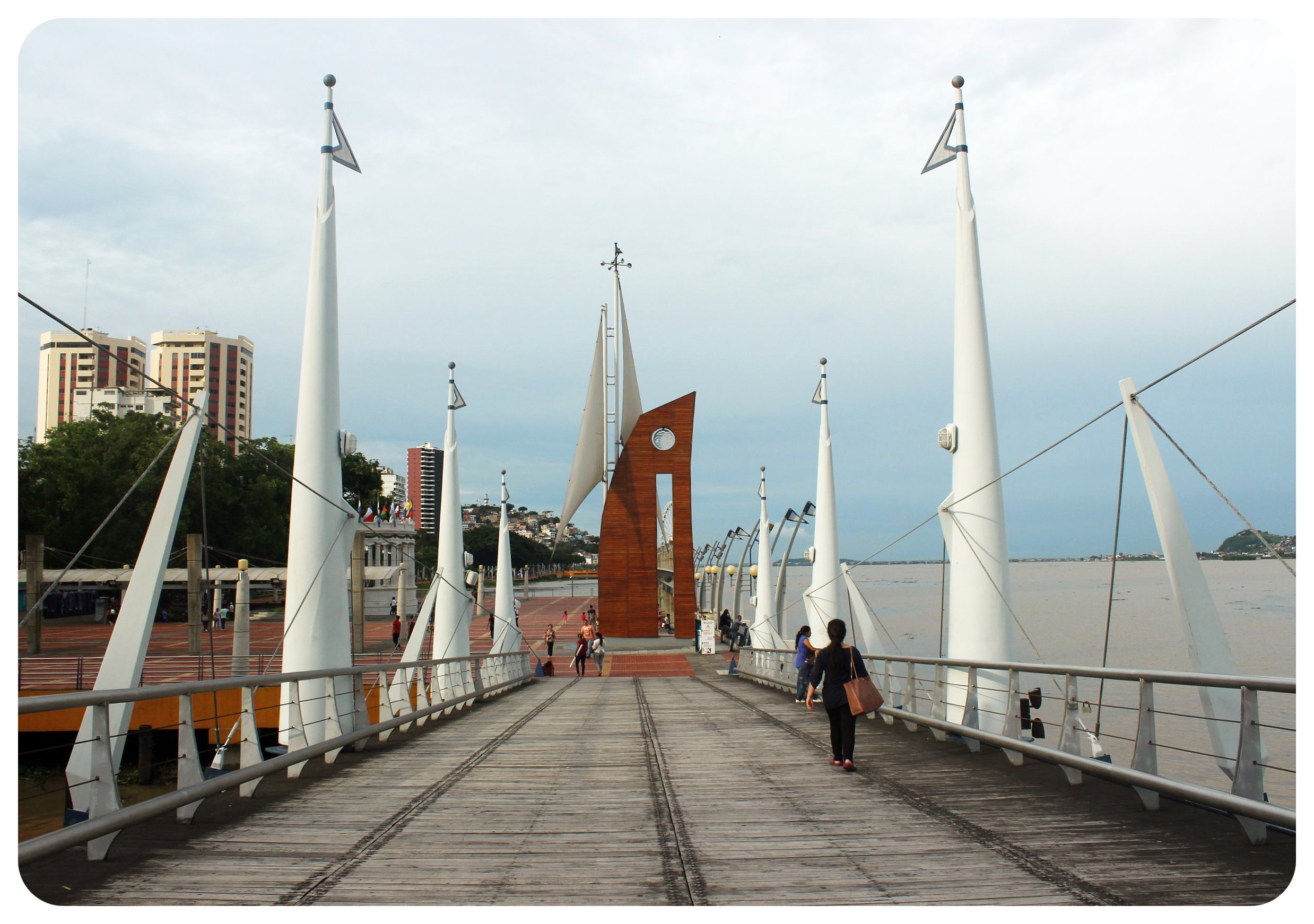 The Malecon 2000 was one of the most extensive urban-renewal projects in South America. Before the malecon was built, this area of the city wasn’t very popular, but these days, the malecon is teeming with people day and night. The boardwalk is made up of ponds, playgrounds, sculptures, gardens and offers sweeping river views. There are restaurants and coffee shops, and even a Moorish clock tower.
The Malecon 2000 was one of the most extensive urban-renewal projects in South America. Before the malecon was built, this area of the city wasn’t very popular, but these days, the malecon is teeming with people day and night. The boardwalk is made up of ponds, playgrounds, sculptures, gardens and offers sweeping river views. There are restaurants and coffee shops, and even a Moorish clock tower.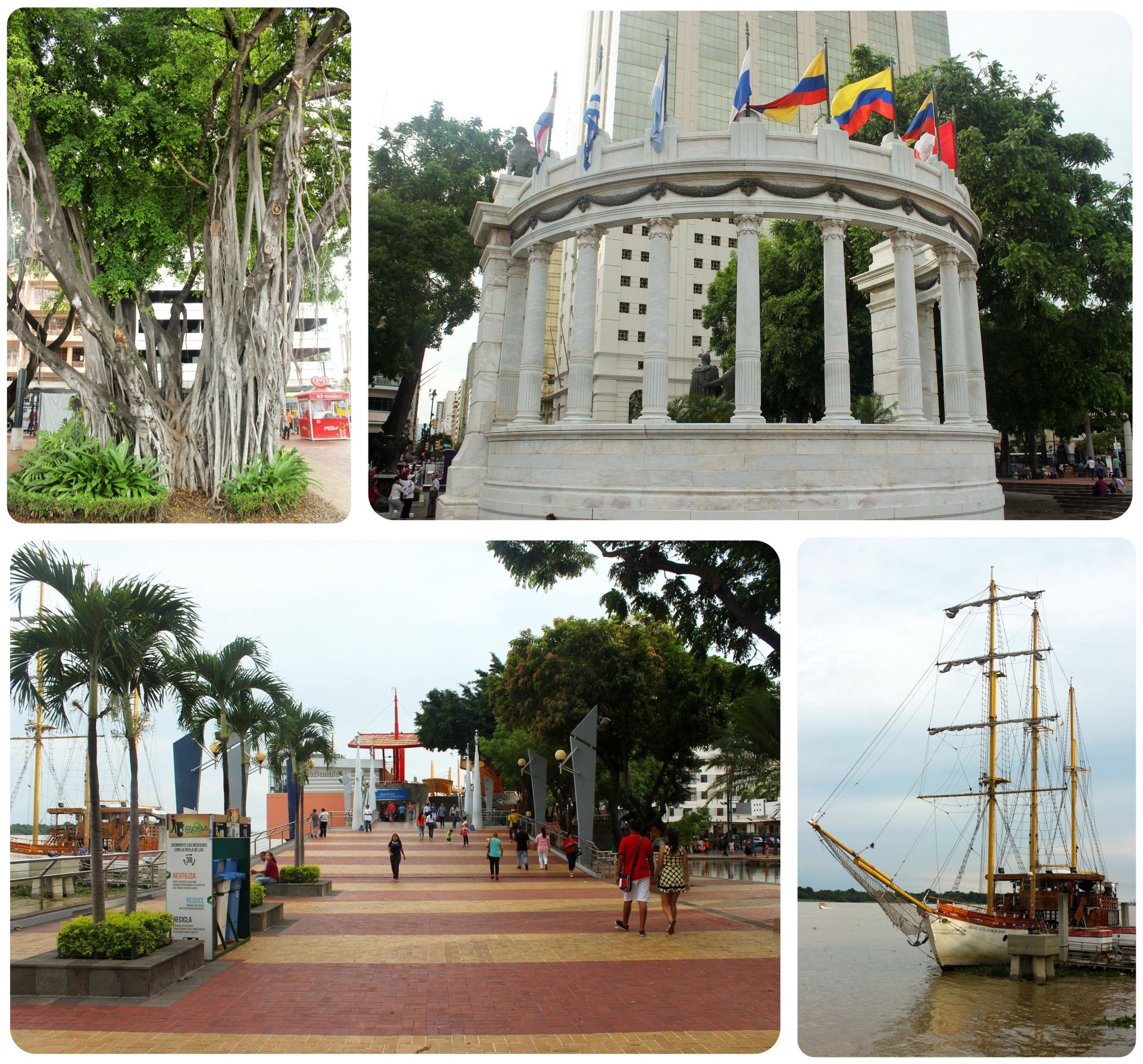
The Malecon stretches 2.5km along the bank of the wide Río Guayas, from its southernmost point at the Mercado Sur, a handicraft market, to Cerro Santa Ana and Las Peñas in the north (which I would visit later),and was the perfect place for an early morning run – the only time it wasn’t too hot to exercise outside.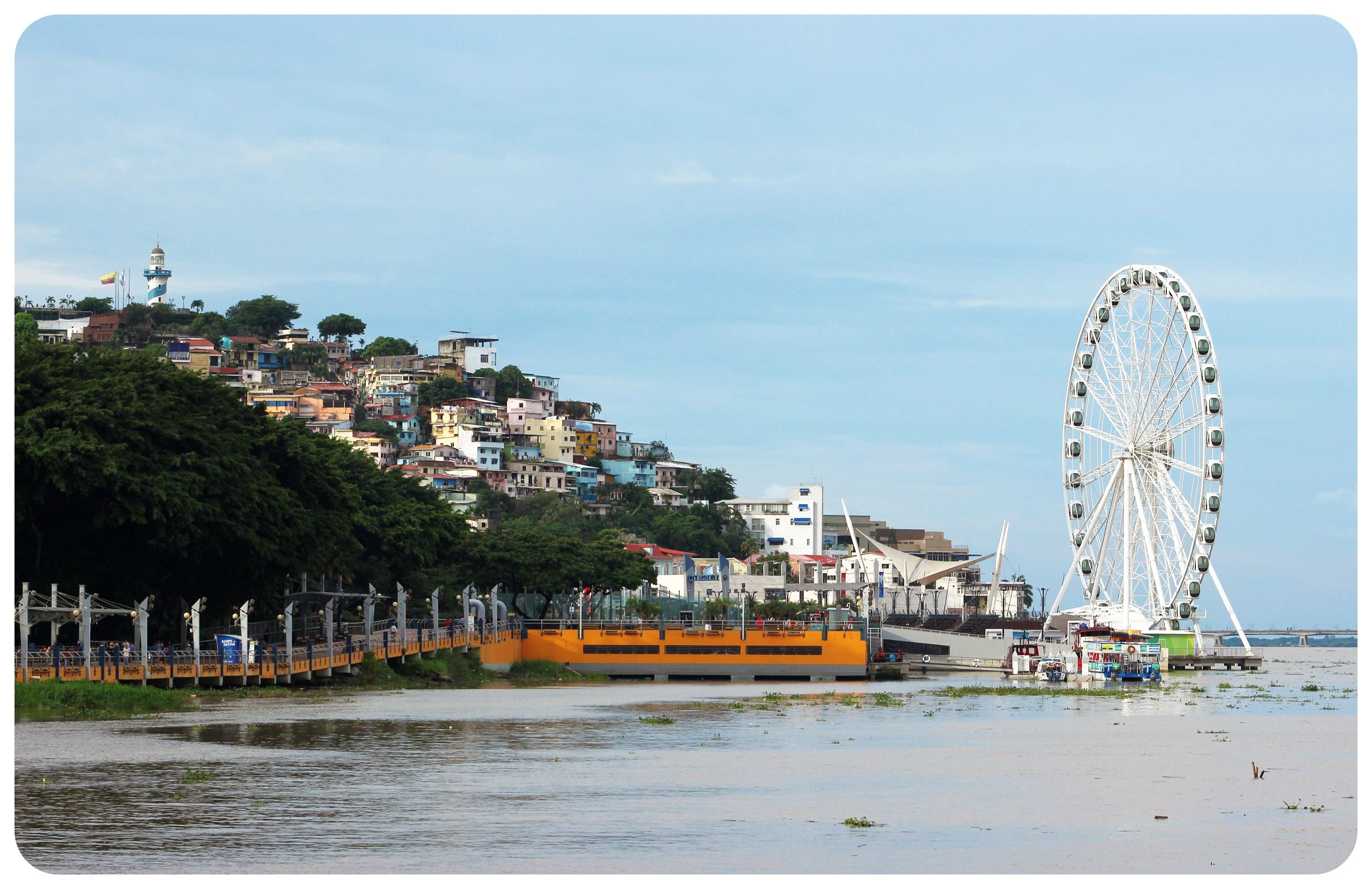 The Malecon is truly beautiful, there is even a Ferris wheel for panoramic views over the city, and an IMAX cinema, where I treated myself to a viewing of LaLa Land one night.
The Malecon is truly beautiful, there is even a Ferris wheel for panoramic views over the city, and an IMAX cinema, where I treated myself to a viewing of LaLa Land one night.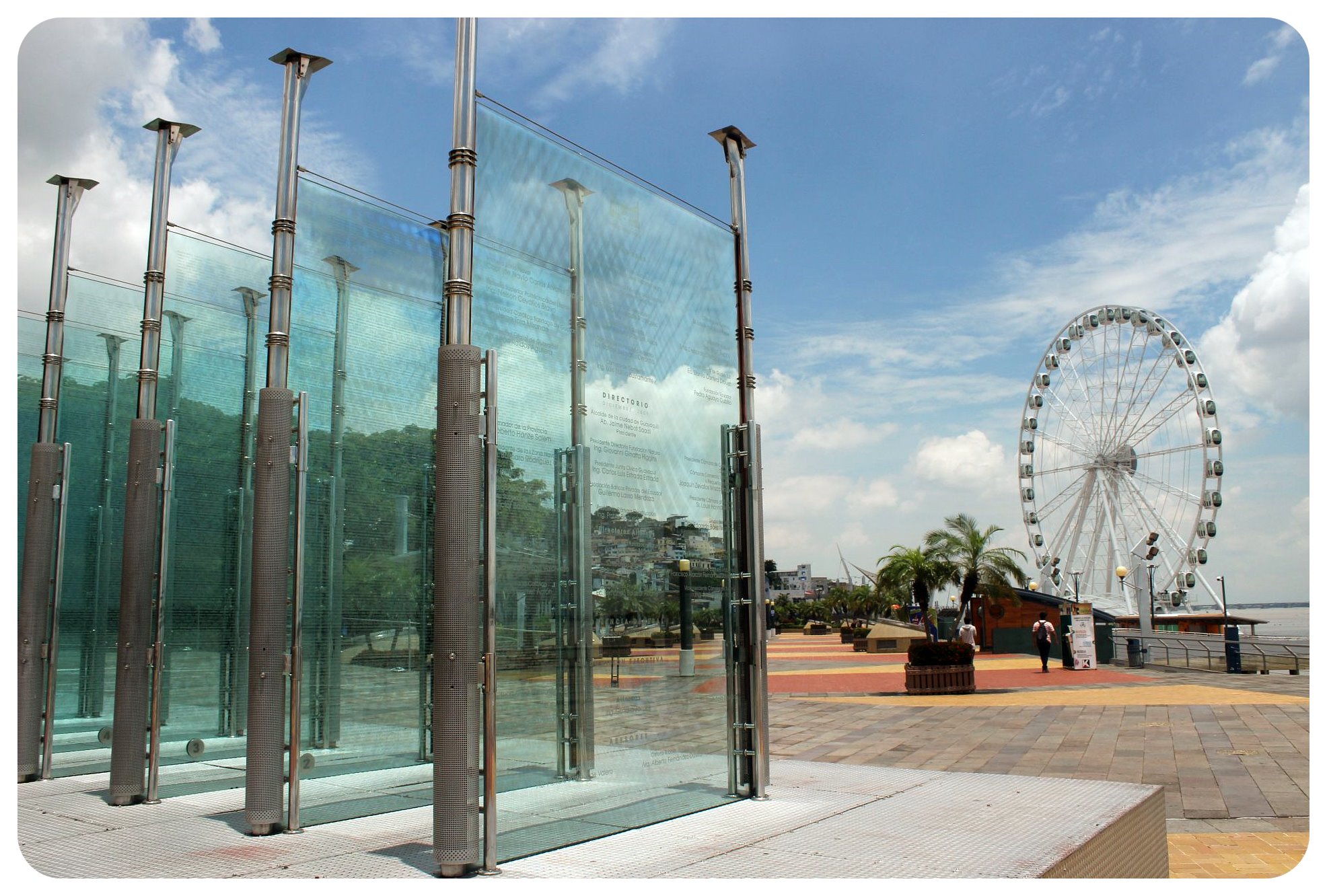 The Sweet & Coffee café right on the Malecon was nice enough to while away an afternoon or to pick up an iced drink and go on a stroll through the manicured parks next to the boardwalk. Ice cream vendors line the boardwalk, and they were constantly busy since Guayaquil was always hot. Rain or shine, the pressing heat never disappeared. Even at night, temperatures would rarely go below 80°F.
The Sweet & Coffee café right on the Malecon was nice enough to while away an afternoon or to pick up an iced drink and go on a stroll through the manicured parks next to the boardwalk. Ice cream vendors line the boardwalk, and they were constantly busy since Guayaquil was always hot. Rain or shine, the pressing heat never disappeared. Even at night, temperatures would rarely go below 80°F. I had read about a park in the city center that supposedly was filled with iguanas, and even though I’d seen plenty of iguanas in the Galápagos Islands, I wasn’t tired of them yet, and I was excited to check out the park and see if it was indeed filled with iguanas.
I had read about a park in the city center that supposedly was filled with iguanas, and even though I’d seen plenty of iguanas in the Galápagos Islands, I wasn’t tired of them yet, and I was excited to check out the park and see if it was indeed filled with iguanas.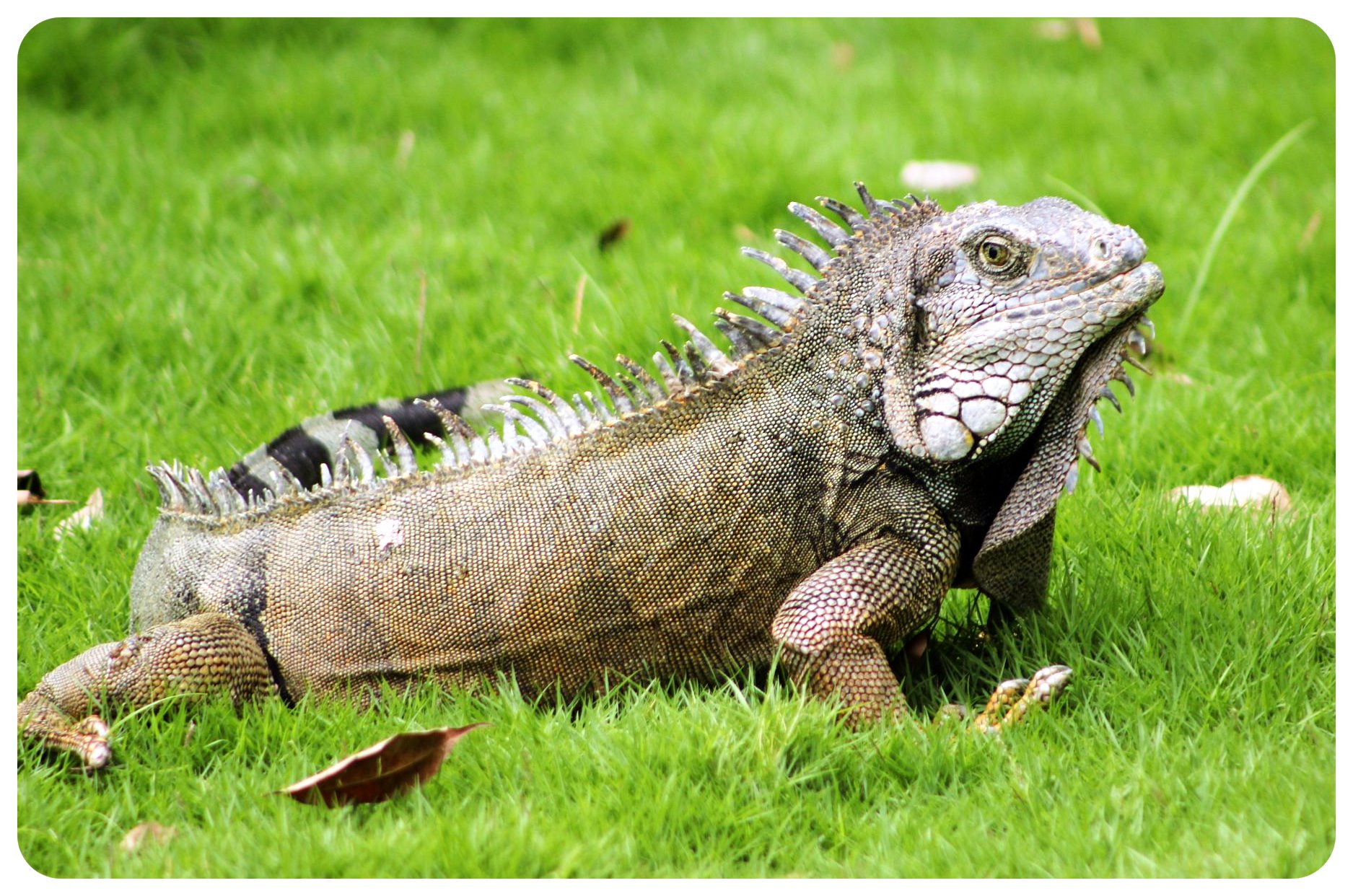 The guide book had not lied: there were dozens of iguanas hanging out everywhere in the small park, with people touching them as if they were fluffy little bunnies instead of leathery reptiles.
The guide book had not lied: there were dozens of iguanas hanging out everywhere in the small park, with people touching them as if they were fluffy little bunnies instead of leathery reptiles. I was amazed how gentle they were and seemingly unafraid of people – almost like their distant relatives out in the Galapagos Islands. A lady had a stash of ‘iguana food’ on one of the benches – basically just lettuce cut into small pieces – which she was selling. I invested 50 cents in a bag of lettuce and within minutes I was surrounded by hungry iguanas of all shapes and sizes. That afternoon ended up being my fondest memory of Guayaquil.
I was amazed how gentle they were and seemingly unafraid of people – almost like their distant relatives out in the Galapagos Islands. A lady had a stash of ‘iguana food’ on one of the benches – basically just lettuce cut into small pieces – which she was selling. I invested 50 cents in a bag of lettuce and within minutes I was surrounded by hungry iguanas of all shapes and sizes. That afternoon ended up being my fondest memory of Guayaquil.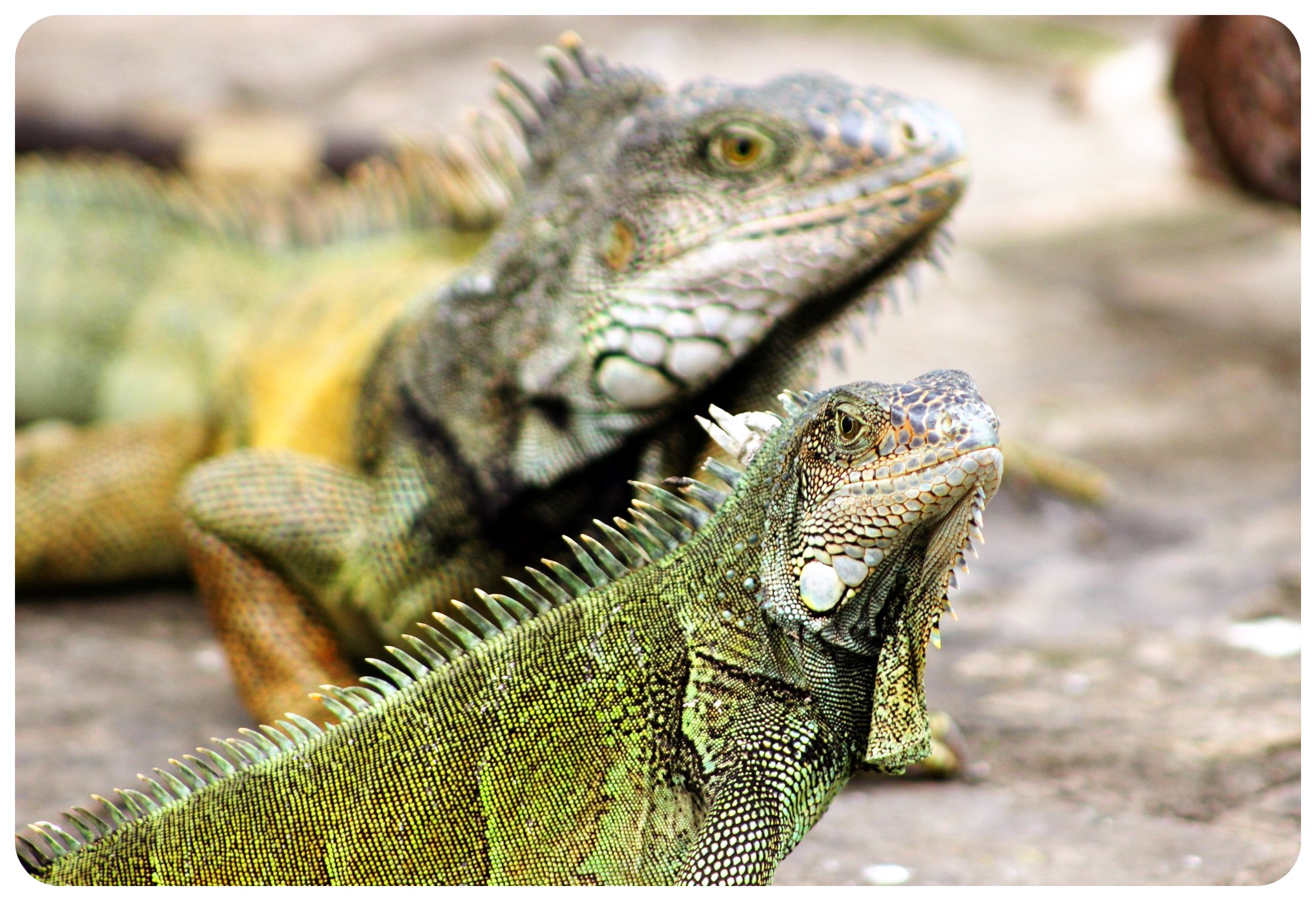
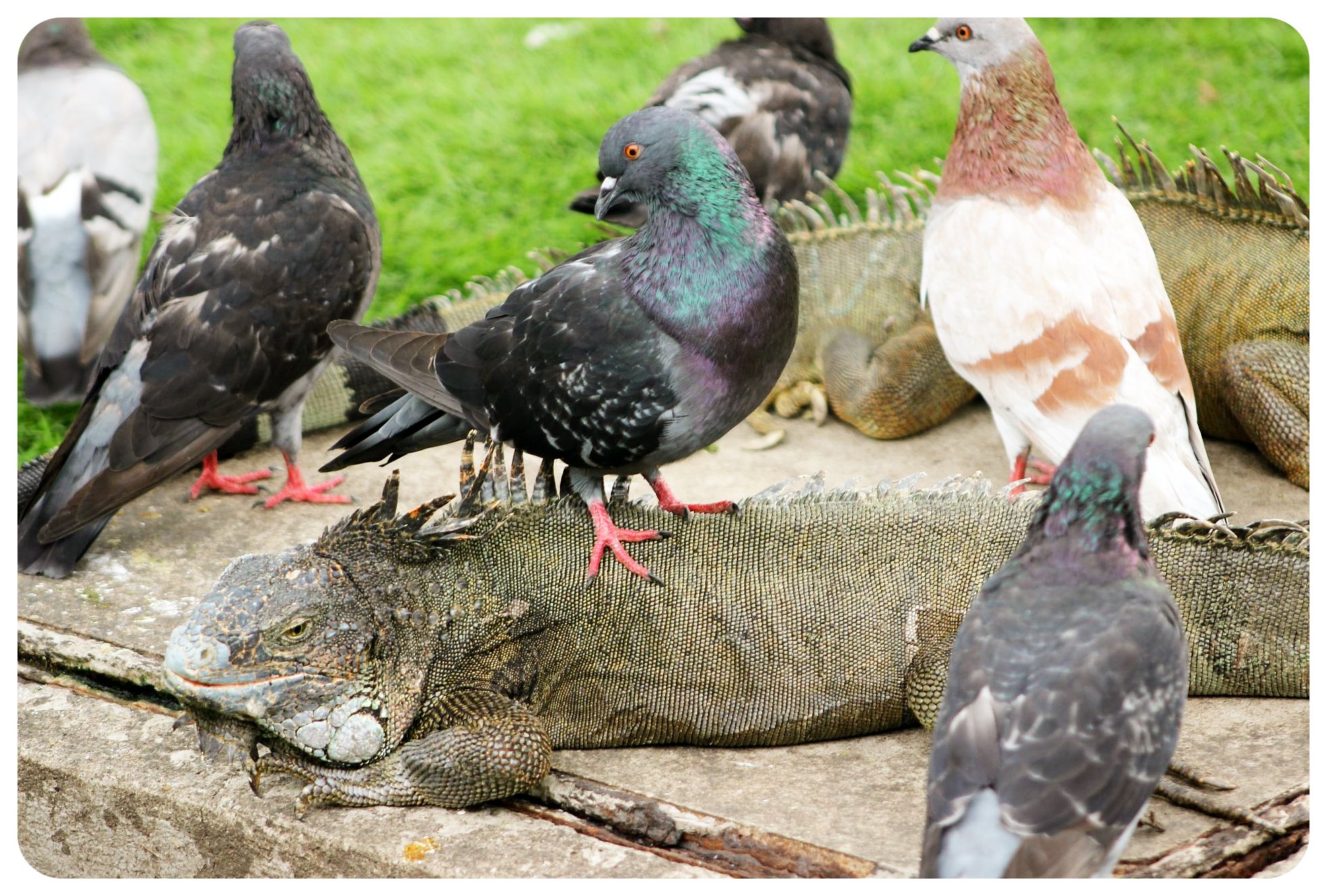 Even though I spent plenty of time wandering the streets of the city, I just didn’t feel much of a connection to Guayaquil. A city of 2.69 million people, it is the largest and the most populous city in Ecuador (yes, bigger than Quito!), and it seemed mainly to be just that: a big, busy city.
Even though I spent plenty of time wandering the streets of the city, I just didn’t feel much of a connection to Guayaquil. A city of 2.69 million people, it is the largest and the most populous city in Ecuador (yes, bigger than Quito!), and it seemed mainly to be just that: a big, busy city.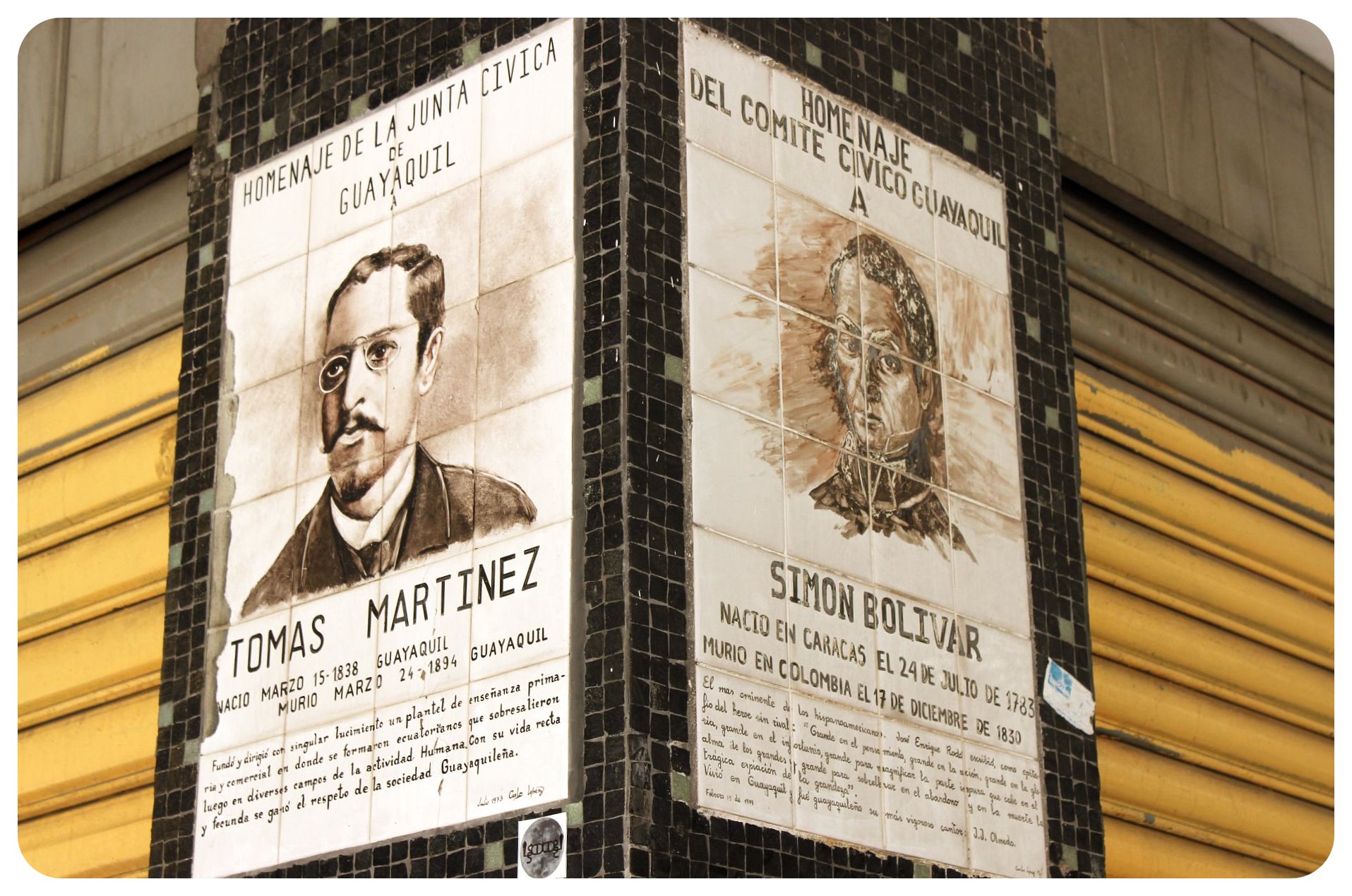 I left the main sight of Guayaquil for my last day, when, for the first time during my stay, the clouds opened up and gave way for bright blue skies: the perfect day to hike up the 432 stairs to Cerro Santa Ana, where you can climb to the top of a lighthouse atop the hill (in case 400+ stairs aren’t enough), which offers beautiful 360 panoramic vistas over Guayaquil.
I left the main sight of Guayaquil for my last day, when, for the first time during my stay, the clouds opened up and gave way for bright blue skies: the perfect day to hike up the 432 stairs to Cerro Santa Ana, where you can climb to the top of a lighthouse atop the hill (in case 400+ stairs aren’t enough), which offers beautiful 360 panoramic vistas over Guayaquil.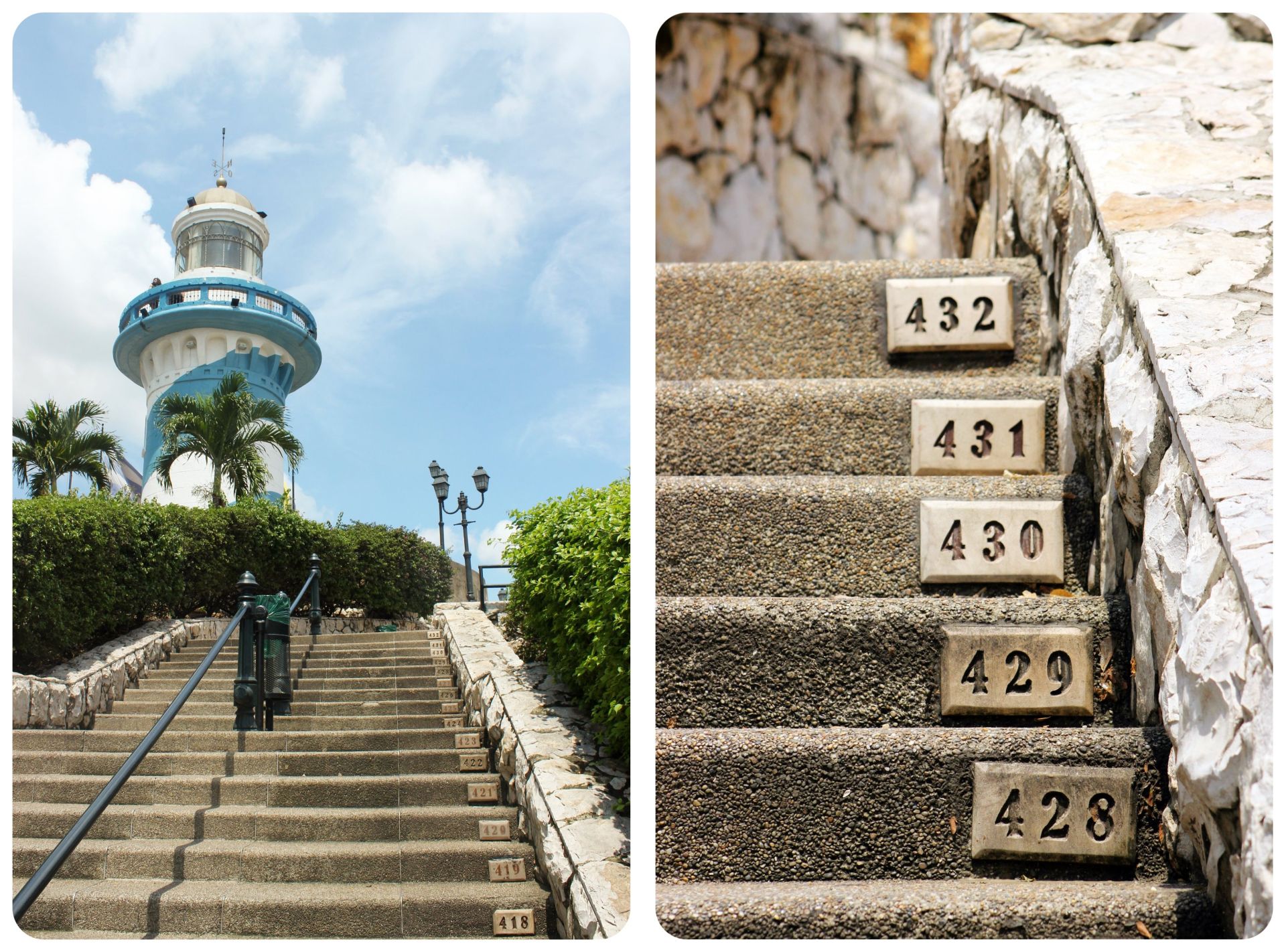 From up there, you can also admire the highest building in all of Ecuador, a modern twisted skyscraper named The Point, and an architecturally interesting structure, albeit at 137 meters (449 feet) tall it is a moderately sized skyscraper in the scheme of things – at least for someone who is used to North American metropoles.
From up there, you can also admire the highest building in all of Ecuador, a modern twisted skyscraper named The Point, and an architecturally interesting structure, albeit at 137 meters (449 feet) tall it is a moderately sized skyscraper in the scheme of things – at least for someone who is used to North American metropoles. Guayaquil has one of the largest and most important sea ports in all of South America, and the building sits right next to the Guayas River which flows into the Pacific a few miles from there.
Guayaquil has one of the largest and most important sea ports in all of South America, and the building sits right next to the Guayas River which flows into the Pacific a few miles from there.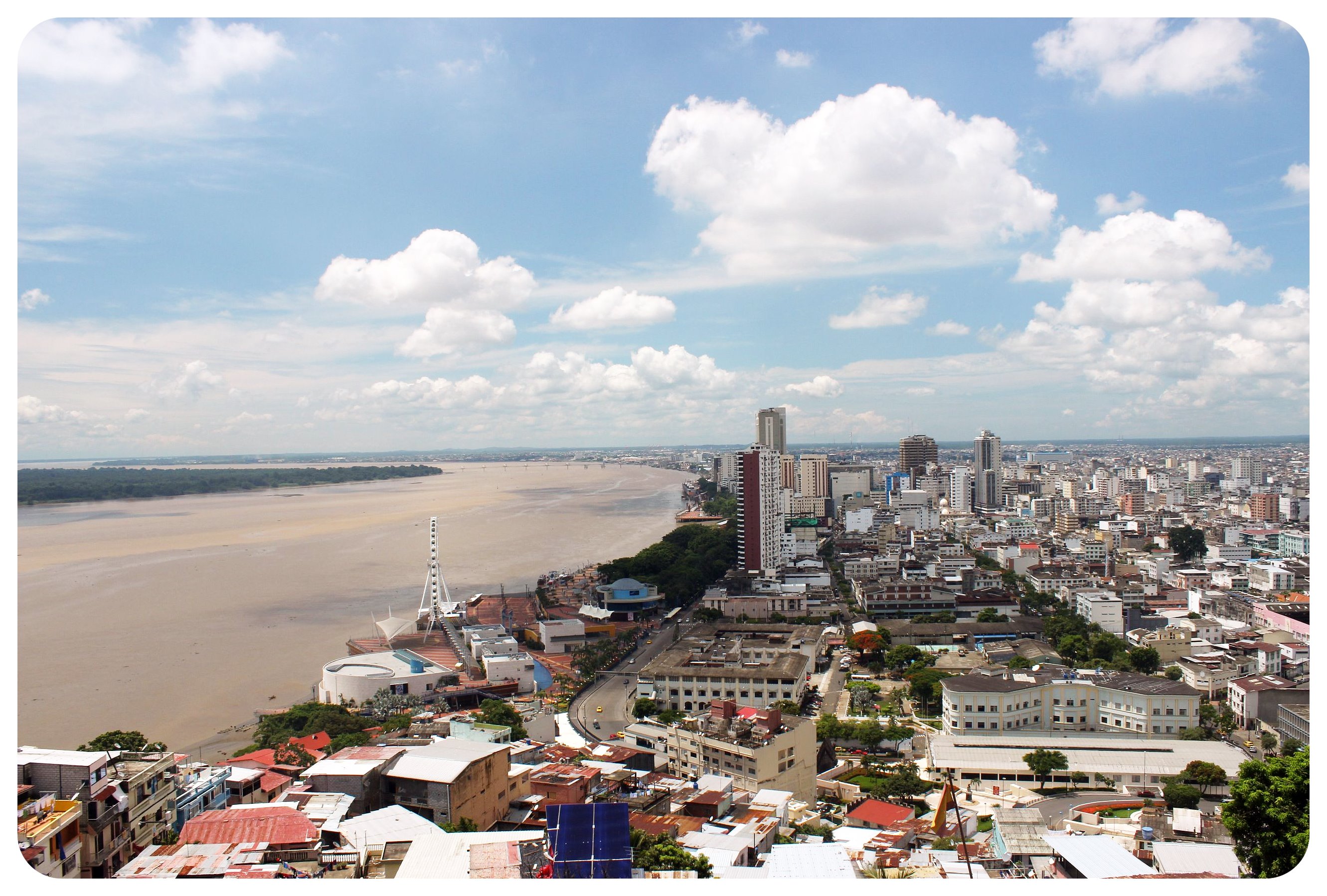 Even though I left early in the morning for my climb up the hill, I was drenched in sweat by the time I reached the top, but the views were well worth me huffing and puffing my way up the steep little alleyways.
Even though I left early in the morning for my climb up the hill, I was drenched in sweat by the time I reached the top, but the views were well worth me huffing and puffing my way up the steep little alleyways.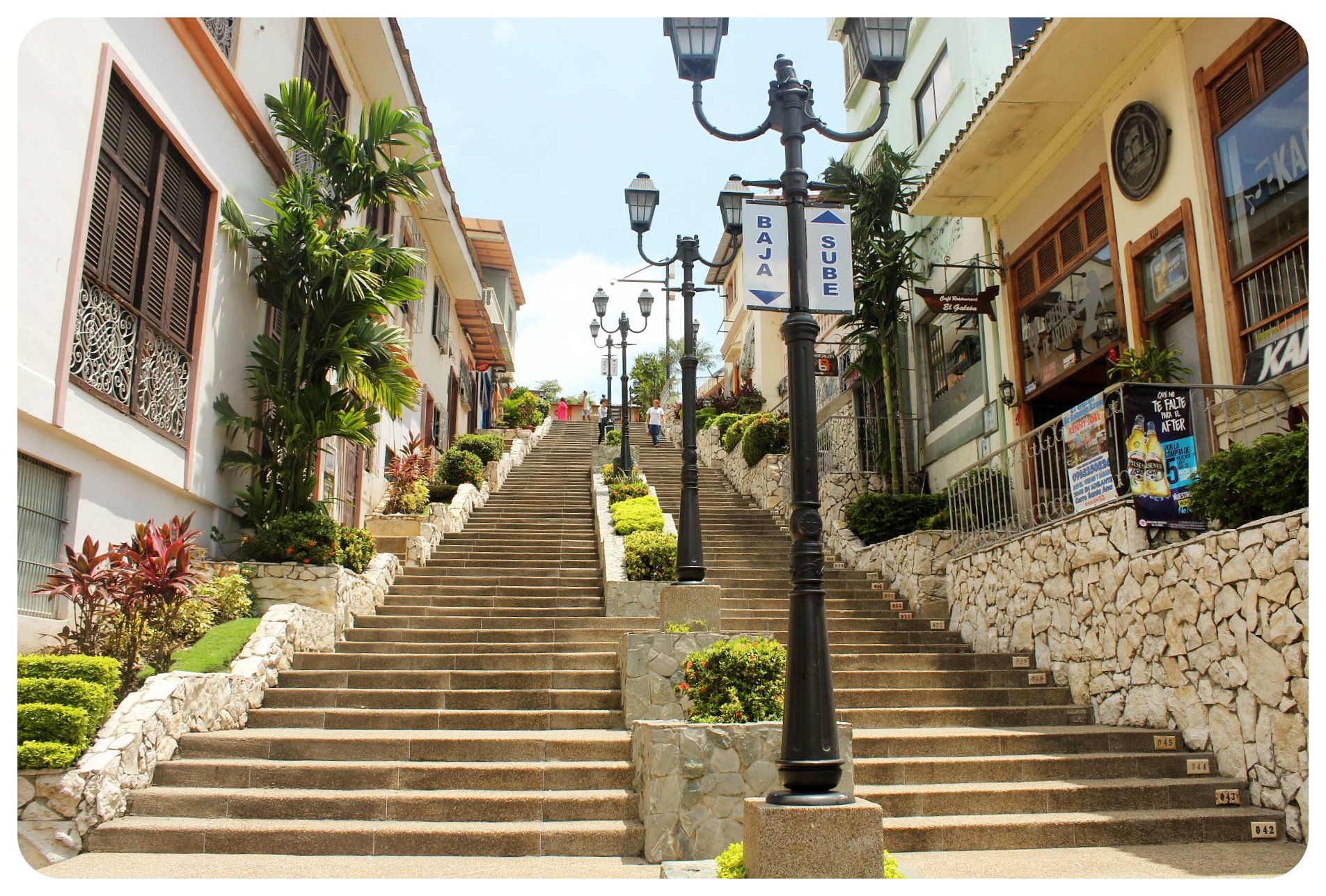 The stairs lead right through Las Peñas, Guayaquil’s oldest neighborhood. The houses there are more colorful than anywhere else in the city, and some of them have stunning wooden frames and balconies. At 400 years old it is one the oldest and best preserved neighborhoods in the entire country, which is why it was declared a ‘Cultural Heritage Of Ecuador’.
The stairs lead right through Las Peñas, Guayaquil’s oldest neighborhood. The houses there are more colorful than anywhere else in the city, and some of them have stunning wooden frames and balconies. At 400 years old it is one the oldest and best preserved neighborhoods in the entire country, which is why it was declared a ‘Cultural Heritage Of Ecuador’.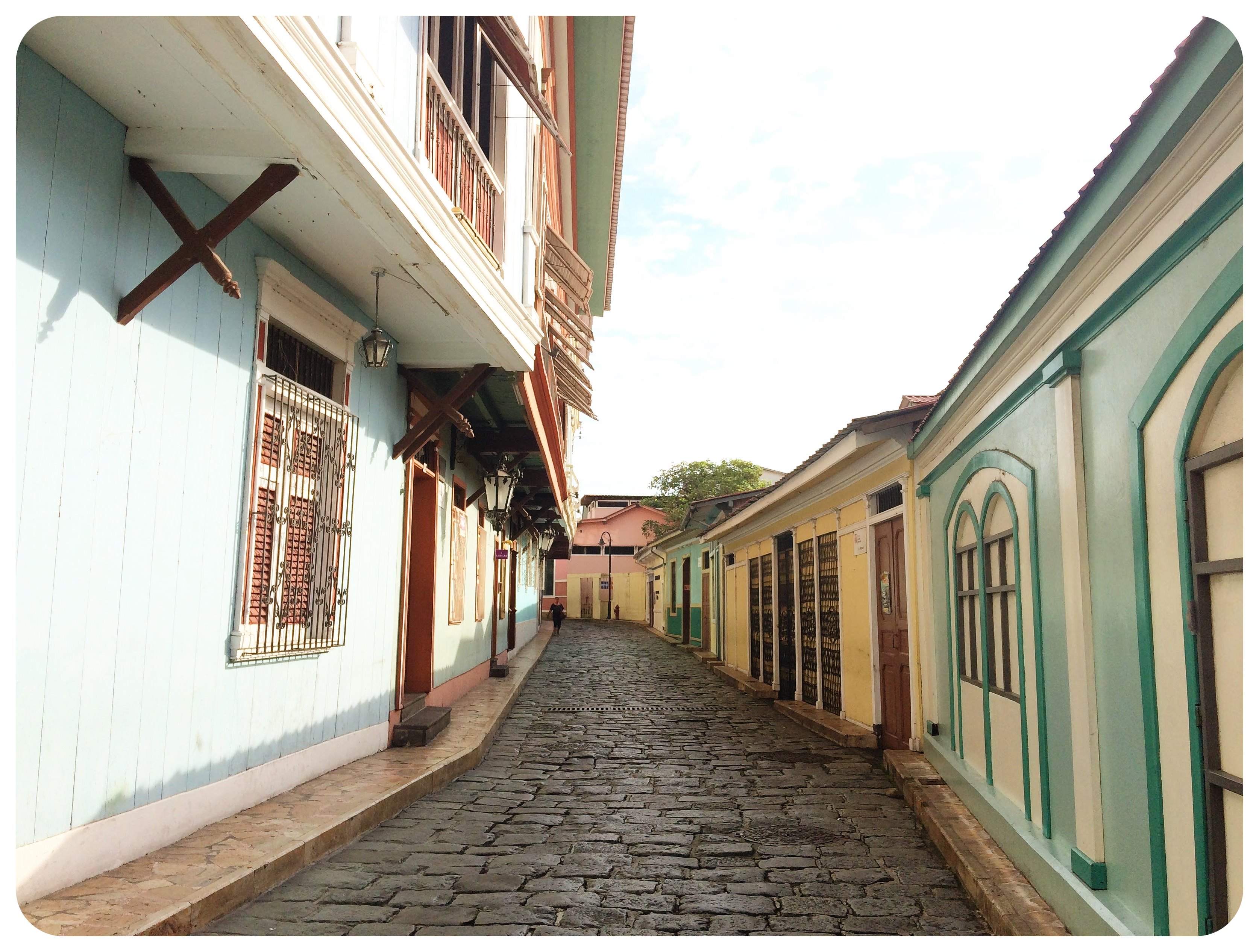 Las Peñas used to be Guayaquil’s poorest and most dangerous neighborhood until a regeneration project transformed its ramshackle buildings into an eye-catching sequence of brightly painted houses, restaurants, bars and shops. It takes its name from the cliffs and limestone rocks that formed the hill (Peñas = rocks).
Las Peñas used to be Guayaquil’s poorest and most dangerous neighborhood until a regeneration project transformed its ramshackle buildings into an eye-catching sequence of brightly painted houses, restaurants, bars and shops. It takes its name from the cliffs and limestone rocks that formed the hill (Peñas = rocks).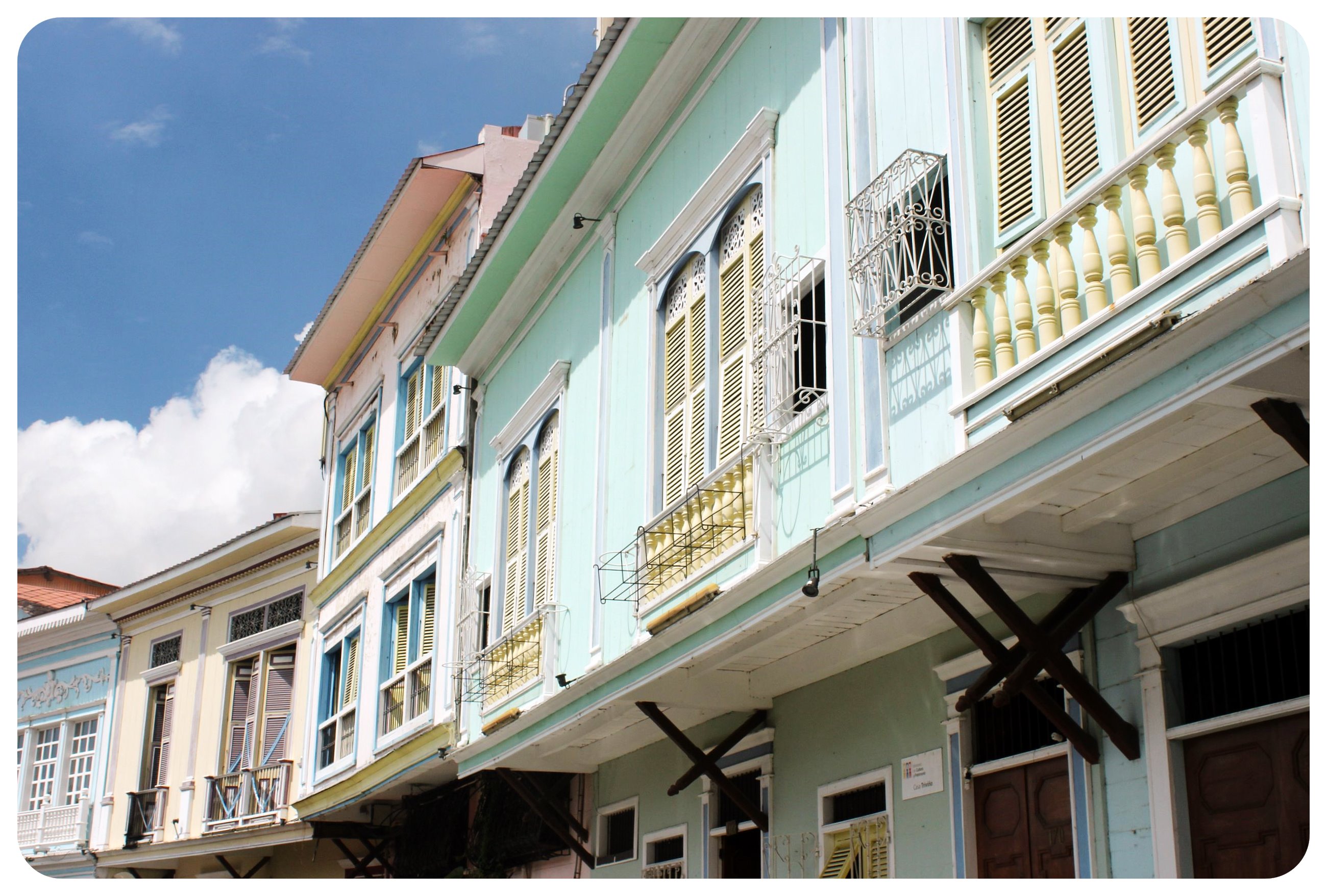 This was easily my favorite part of the city – everything Guayaquil was lacking in charm and personality could be found here. The little alleyways were filled with clotheslines, kids were playing in the streets and cats were lazing on the hot stonewalls. Many of the wooden houses in Las Peñas have been beautifully restored.
This was easily my favorite part of the city – everything Guayaquil was lacking in charm and personality could be found here. The little alleyways were filled with clotheslines, kids were playing in the streets and cats were lazing on the hot stonewalls. Many of the wooden houses in Las Peñas have been beautifully restored.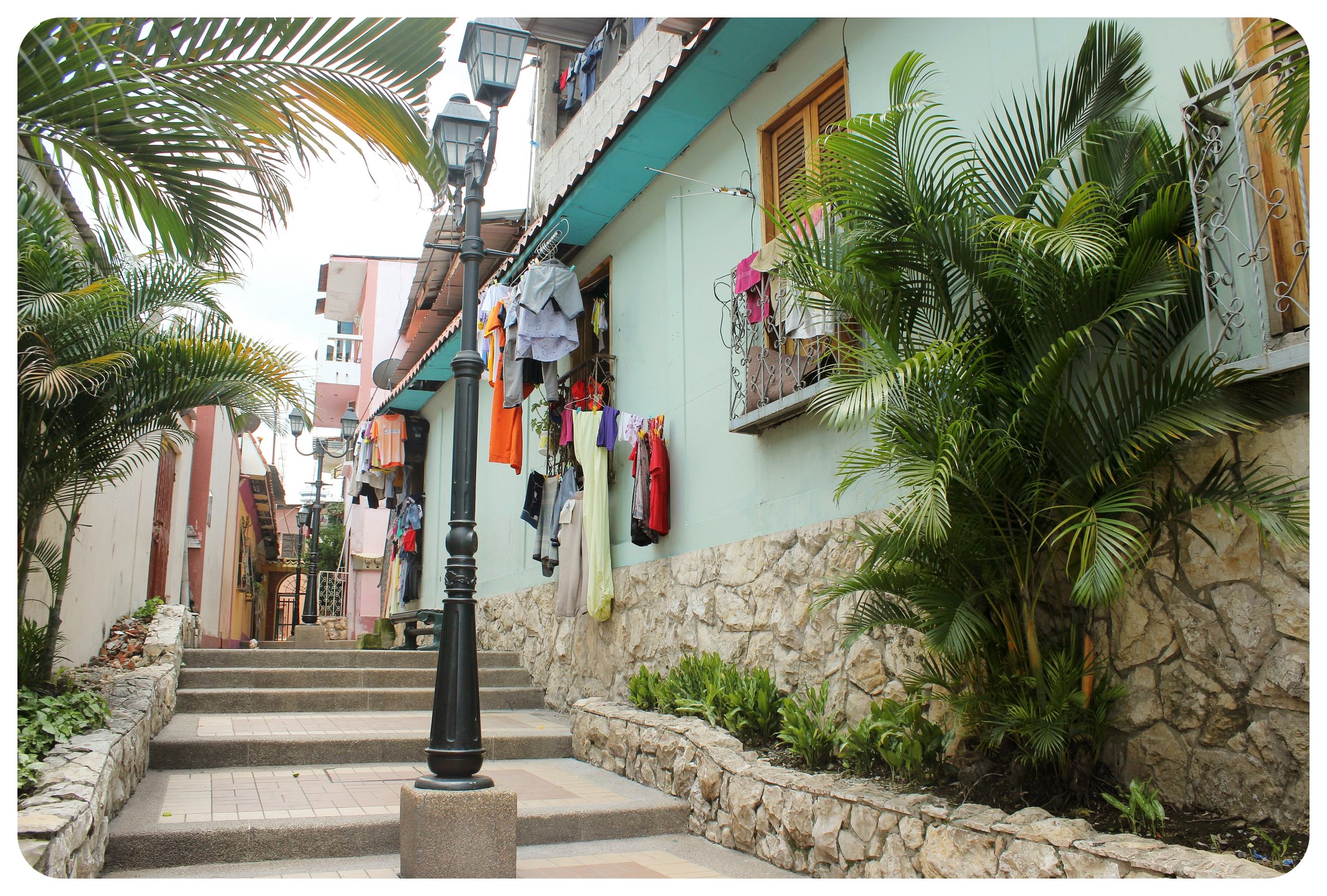 One of Las Peñas’ most famous (temporary) residents? Che Guevara. He passed through Guayaquil in 1953 on his famous South American voyage. Back then, Las Peñas was a crumbling, poverty-ridden neighborhood. Che gave free pediatric assistance to its inhabitants. Ernest Hemingway and Pablo Neruda also spent time there.
One of Las Peñas’ most famous (temporary) residents? Che Guevara. He passed through Guayaquil in 1953 on his famous South American voyage. Back then, Las Peñas was a crumbling, poverty-ridden neighborhood. Che gave free pediatric assistance to its inhabitants. Ernest Hemingway and Pablo Neruda also spent time there.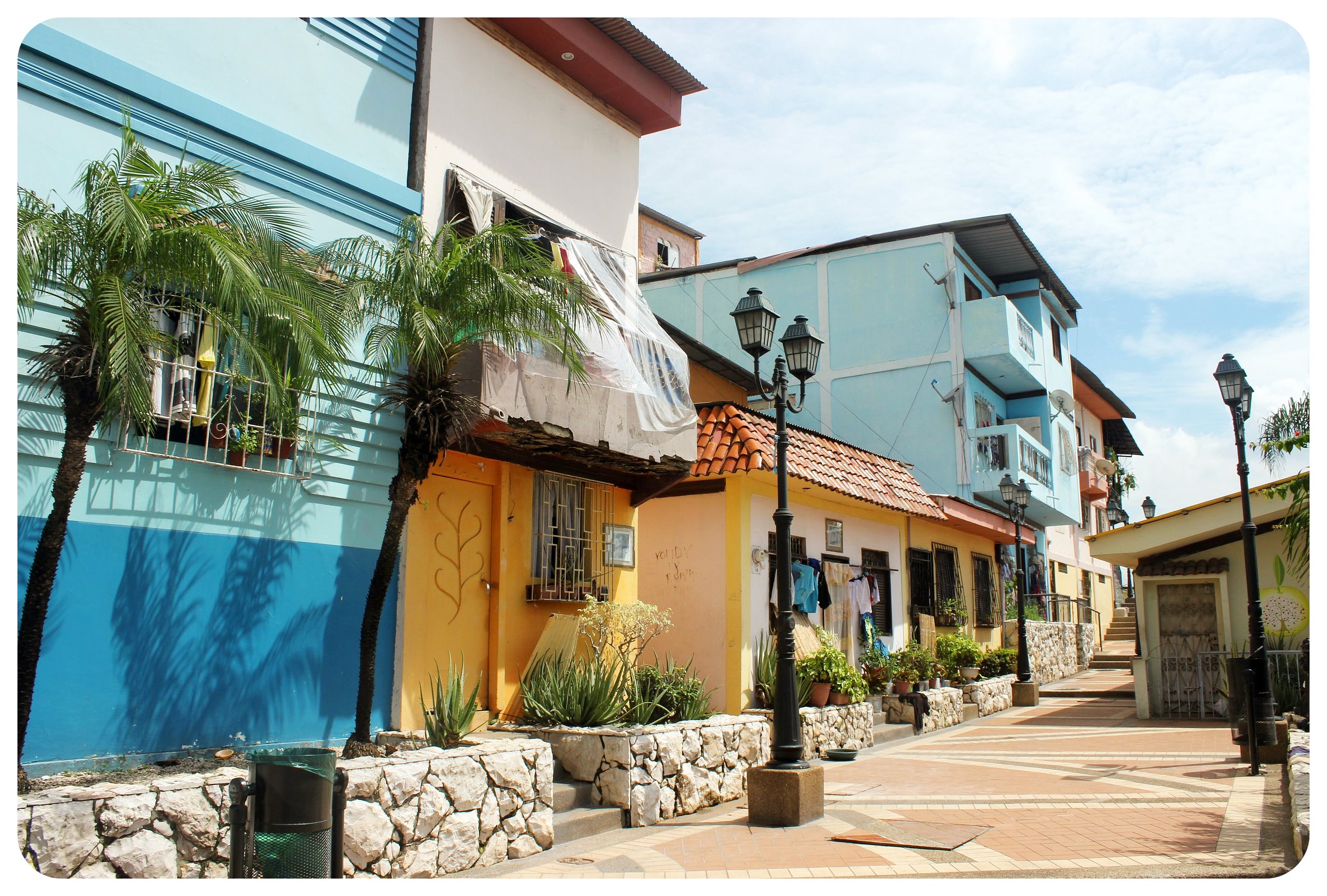 While Guayaquil has come a long way from its poor and crime-ridden past, it is still not the safest city in Ecuador. Several times locals stopped me and told me to put my camera away when I was out taking pictures, and whenever this happens, it makes me feel uneasy.
While Guayaquil has come a long way from its poor and crime-ridden past, it is still not the safest city in Ecuador. Several times locals stopped me and told me to put my camera away when I was out taking pictures, and whenever this happens, it makes me feel uneasy. Luckily though, I ended my time in the city on a good note in Las Peñas, where for the first time, I could see the draw of Guayaquil.
Luckily though, I ended my time in the city on a good note in Las Peñas, where for the first time, I could see the draw of Guayaquil.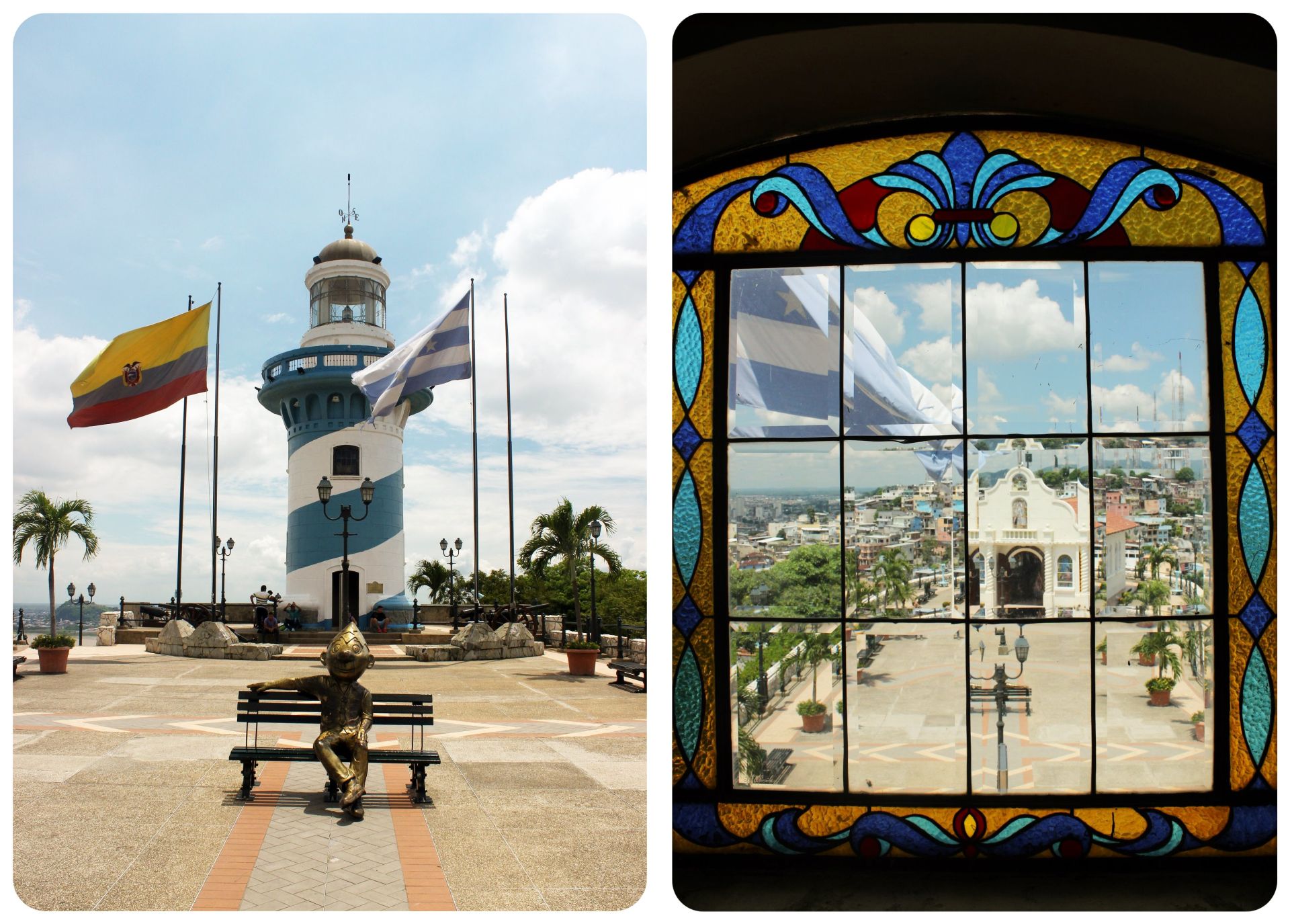 It’s impossible to love every place you visit, and I was happy when I boarded the bus for my next destination: Montañita, Ecuador’s most famous beach town.
It’s impossible to love every place you visit, and I was happy when I boarded the bus for my next destination: Montañita, Ecuador’s most famous beach town.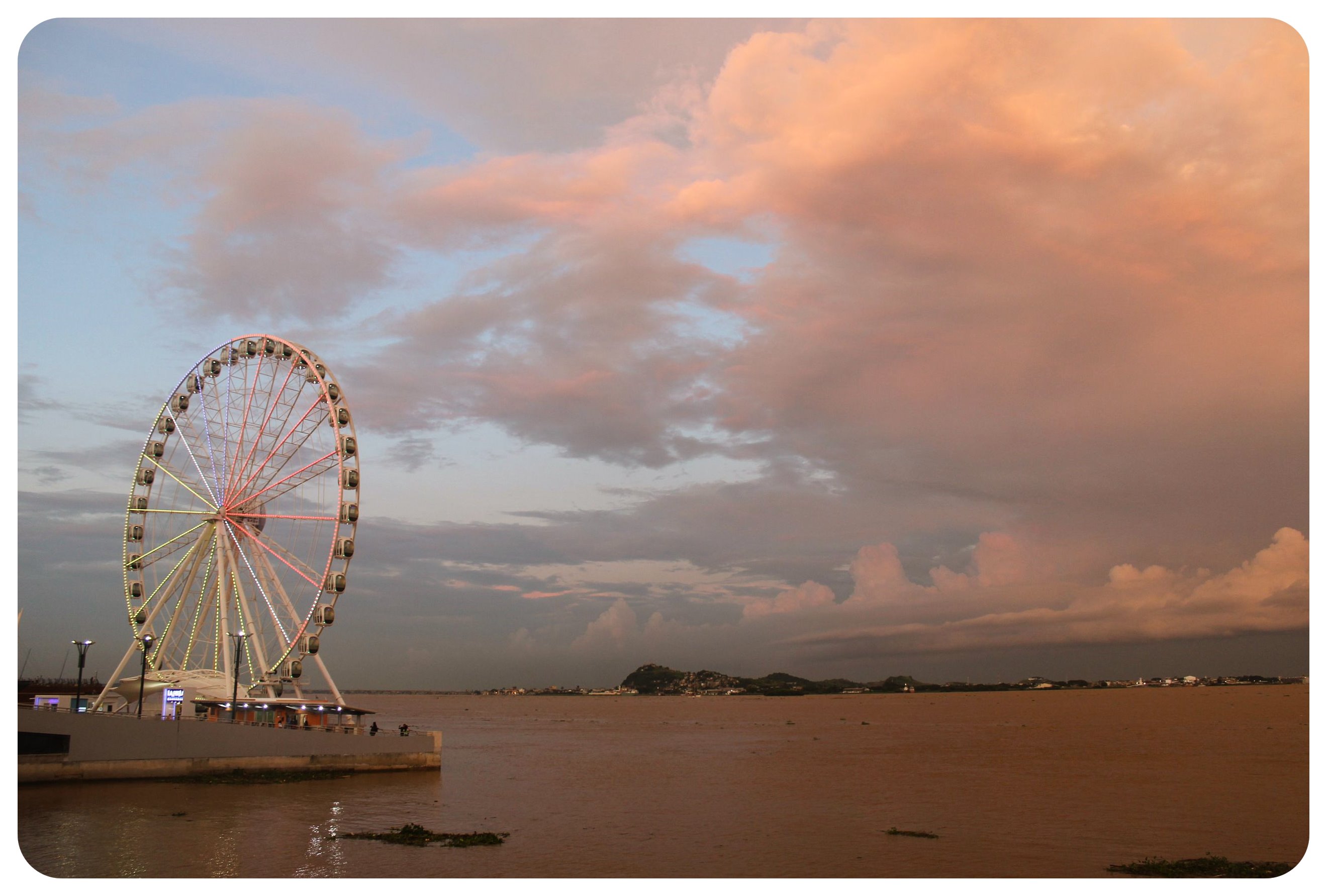

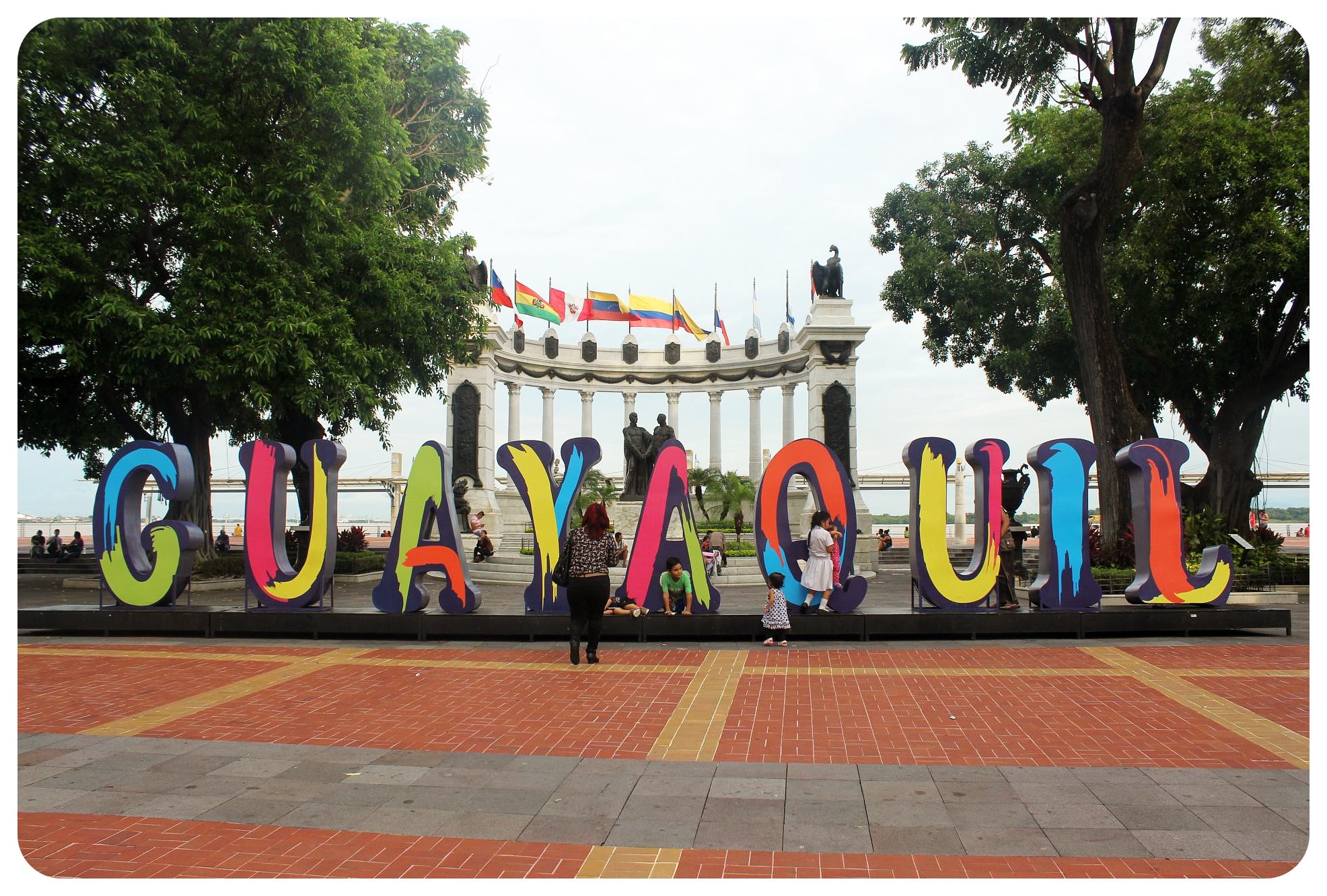
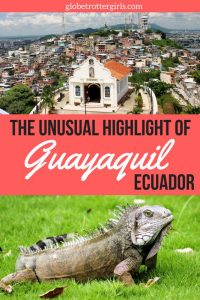


Mantufayo
Thursday 21st of September 2017
If you did not love local Guayaquil food, next time you should have breakfast at El Café de Tere